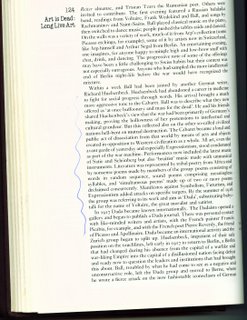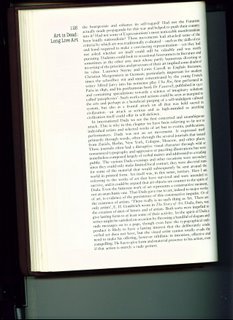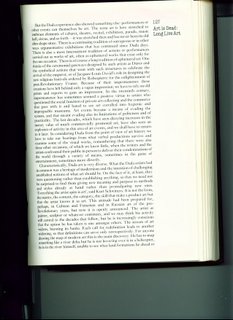greengalloway
As all that is solid melts to air and everything holy is profaned...
Wednesday, November 30, 2005
In every dream home: a nuclear reactor
In keeping with the postmodernist theme, the text is presented as a "work in regress''.
Now read on...
It should be easy enough. All I have to do is summarise a short (14 page) chapter on "The Postmodern Mind" which comes at the end of a rapid sprint through The Passions of the Western Mind- which kicks off with the ancient Greeks and ends in 1991. At least that was when the book was published.
Instead I have spent an hour listening to a cd of classic house anthems from circa 1991[e.g. Oceanic: Insanity : crazy fever burning in my soul...take me into insanity ...dreaming tripping into insanity- thought I had it on 12" vinyl but no trace, not in this reality] whilst lying down with the open book resting on my stomach.
Lets do random sampling
in its most general and widespread form , the postmodern mind may be viewed as an open ended, indeterminate set of attitudes that has been shaped by a great diversity of intellectual and cultural currents ; these range from pragmatism, existentialism, Marxism and psychoanalysis to feminism, hermeneutics, deconstruction and post empiricist philosophy of science... Reality is not a solid self contained given but a fluid unfolding process, an 'open universe' continually affected by one's actions and beliefs...The knowing subject is never disengaged from the body or from the world, which form the background and condition of every cognitive act.
The prevalence of the Kuhnian concept of 'paradigms' in current discourse is highly characteristic of postmodern thought, reflecting a critical awareness of the mind's fundamentally interpretive nature.... The world does not exist as a thing-in-itself, independent of interpretation; rather it comes into being only in and through interpretations. The subject of knowledge is already embedded in the object of knowledge; the human mind never stands outside the world... hence the nature of truth and reality, in science no less than philosophy, religion, or art, is radically ambiguous.
The postmodern human exists in a universe whose significance is at once utterly open and without warrantable foundation.... here the Cartesian intellect has reached its furthest point of development, doubting all, applying a systematic scepticism to every possible meaning...
old assumptions remain blunderingly in force , providing an increasingly unworkable and dangerous blueprint for human thought and activity....
The dialectical challenge felt by many is to evolve a cultural vision that...would yet somehow bring an authentic and fruitful coherence out of the present fragmentation. [Richard Tarnas: Passion of the Western Mind: Pimlico: 1991]
Back to the old house music: " let me be your fantasy"... the fantasy being the ability to bring 'an authentic and fruitful cohesion' out of the chaos. To evolve a cultural vision.... Evolve being the key word. Ooops, got stuck again. Why am I stuck? Synchronity- cd stuck now on Two bad Mice. Change the record! Rave Anthems 2. First track: Moby/ Go. Wow, this is such a powerful piece of music. I will put it on repeat.
Back to evolution. I guess what is confusing me is the attempt to mix together a set of 'scientific' sources of information which may not meld and merge into a coherent narrative. Examples being George Dyson/ Darwin Amongst the Machines and the latest 'Science of Discworld' book, Darwin's Watch. [Pratchett, Stewart, Cohen]
Darwin's Watch is focused on physical/ biological evolution [ with a subtext of opposition to 'intelligent design'], whereas Darwin Amongst the Machines is focused on the evolution/ emergence of non-biological 'intelligence'.
Common to both is a denial/ refusal of reductionist absolutism. That 'intelligence' is an emergent property of complex systems and so there is no need to invoke an 'intelligent designer' to explain biological/ artificial life on earth.
The Dyson strand is the one which needs to be developed if intelligent design (= creationism = reductionist absolutism) is to be properly refuted. This is a cyberpunk/ chaos magick theme. Dyson's argument is "Yes, we as humans have created complex machines and tried to imbue them with intelligence, but any intelligence which our machines will one day exhibit will be the product of evolution rather than our intentional design.".
The further implication is that our 'intelligence' is also the product of evolution rather than divine design- that out of the complexity of our brains' neural networks the property called 'intelligence' [ = consciousness] has emerged 'naturally'. Aha, says the advocate of intelligent design, but who designed 'nature' [= reality = the universe etc] such that intelligence would emerge out of physical existence ?
Good question. The answer seems to be that evolution also works at a cosmological level. Most potential universes are unstable and so would cease to exist within milli-seconds of their creation out of nothing (which is what our universe emerged from about 15 billion years ago). No less than our individual existence depends upon the unique sexual union of our parents - which distinguishes me from most of you- our collective existence depends on the unique set of physical constrains/ properties which give stability to the universe we inhabit. It is a logic loop - if a stable universe did not exist, then we would not exist within it to wonder why it and we exist... if my father had not met my mother, I would not exist. If your mother had not met your father, neither would you. This sequence of 'ifs' can be extended backwards to the origin of our universe with no need to invoke any pre-existant 'intelligent designer' or G*d.
But what happens if we look forwards? It looks a bit gloomy. By distinguishing our intelligence/ consciousness/ existence as human beings from the totality of existence (which is no less intelligent/ conscious than we are, since we are part of rather than apart from 'it') , we have isolated ourselves from the totality of reality, and from evolution. Thus we are subject to entropy, to the law of diminishing returns. The more we try to force the world into conformity with our absolutist/ reductionist vision of reality, the closer we come to the extinction of our existence as homo sapiens, as human beings.
Riders on the Storm/ The Doors/ LA Woman/ 1970
The world on you depends
Our life will never end...
Into this house we're born
Into this world we're thrown...
Riders on the storm...
Waves crash onto the beach. We have left our footprints on the sand, but the tide is turning. Soon it will wash our footprints away. When they are gone, who (or what) will know that we ever existed?
Nuclear power.
Our nuclear footprint will remain on the beach. The sands of time fused and vitrified around our absence.Mistah Kurtz may be dead, but his shadow remains, its outline frozen in our very act of becoming 'the horror'.
Too poetic of course. Relax, the problems are mere technicalities. Nuclear waste is not an issue,. at least not one sufficient to scupper the Project. There is an energy gap and we need nuclear to fill it - or we will end up sitting around freezing our butts off in the dark. And nuclear can help us fight global climate change!
OK, so do I need to rehearse, to adumbrate, the pro and anti- positions? No, I don't since that information is already out there/ in here - splashed across front pages of the Independent and the Scotsman today [ Tuesday 29 November 2005 era vulgaris]. What I need to do is articulate the chaotic postmodern countercultural point of many views/ many points of view/ many views of the point/ views of many points.
Which is/ are?
To go nuclear is to regress back to modernity, to the quaintly old-fashioned single world of the 'technical fix'. Got a problem with managing a complex socio-economic environmental energy situation? Who you gonna call? The technocrats!
In a hole? What should you do? Why not dig it so deep we come out the other side of the problem! Lets tunnel our way into a nuclear new age, lets solve all our problems by passing the buck to future generations as yet unborn. What has posterity ever done for us? As economist J.K. Galbraith put it "In the long term, we are all dead.".
Power is Control
The scary thing about alternatives to going nuclear is that they require Power (=Energy) generation to be dispersed across a bewildering range of options and possibilities. Good God, some naive idiots have even suggested that we should reduce our addiction to Power (=Energy), that the exponential growth curves could be flattened out so we get back to life, back to reality!
But if that happens, wouldn't we be in danger of losing Control? If each household was a Creator of Power (= Energy) , then each household , each defined social unit, would acquire an equivalent degree of Control? The whole System, the whole structure of the Spectacle would collapse into Chaos!
1.Power must be Concentrated at the Centre, to be doled out watt by watt, newton by newton to those on the Periphery.
2. Power must never lose its Aura of Danger, must remain a thing too frightening for any but the Elite to Control.
3. Power shapes the World. The World does not shape Power.
Still too poetic.
Power control lies state secrets security .
These are the themes. The contamination of all data. Don't let them see what we are doing. Terrorism. the concentration rather than dispersal, 'devolution. of power.
Compare and contrast two products of Total War. Nuclear power. Computing power.
Alan Turing. General Groves. Von Neumann. Intelligence.... Oakridge and Los Alamos. Bletchley Park. Knowledge as Power.
Visualisation: the different paths and trajectories taken by the flow of knowledge of Nuclear and Computing power. The agencies and institutions created as manifestations of the differing trajectories. Trace them, follow them through from 1940 onwards..
Thought experiment - can you imagine:
i. A nuclear reactor for every home?
ii. A computer for every home?
In every dream home, a heart ache... Roxy Music
Monday, November 28, 2005
Creative Intelligence vs Institutional Power
Both Penny and Gee of Crass were ex-art school students and so had a knowledge of 20th century art movements history e.g. Dada. Dada, as an 'anti-art' /art as political movement, had its direct origins in the Great War/ World War One. I don't know, but strongly suspect that knowledge and awareness of Dada were a factor in the construction of Crass. If so, then just as those involved in the original Dadaist 'Cabaert Voltaire' used their creative intelligence to oppose and negate the institutional power of the patriarchs/ paternalists who instigated and perpetuated the Great War, Crass used their collective creative intelligence (mediated via punk) to oppose and negate the eighties manifestation of institutional power.
Crass were able to focus their assault on consensus reality by picking on the symbolic date of 1984 as an endpoint. But 1984 has been and gone for 21 years past and Dada will soon be 90 years old. The forces of insitutional power aginst which three (nearly four now) generations of the avant garde of creative intelligence [the counterculture spawned by Dada, Surrealists, Situationists, Freaks and Punks] have railed against appear to survive with undimished strength. Millions have died as sacrifices in the pursuit of a New World Order, but the promised land of peace and security remains as much an illusion as it was in 1916.
Why?
The Situationists have given the best explanation. The mass culture of the Society of the Spectacle negates and denies historical conciousness and historical awareness. It instigates collective amnaesia, a form of social Alzheimer's Disease in which as fast as events happen they are forgotten. In particular, what is most forgotten is our own personal and subjective recollection of history.
Wake up!
The world is not a dream. History is reality. The horrors happened. The horror continues as a nightmare- until we can awaken from this dream which is reality.
Celebration Of The Lizard
------The Doors
Lions in the street and roaming
Dogs in heat, rabid, foaming
A beast caged in the heart of a city
The body of his mother
Rotting in the summer ground
He fled the town
He went down South and crossed the border
Left chaos and disorder
Back there over his shoulder
One morning he awoke in a green hotel
With a strange creature groaning beside him
Sweat oozed from its shining skin
is everybody in?
is everybody in?
is everybody in?
the ceremony is about to begin
Wake up!
You can't remember where it was
Had this dream stopped?
The snake was pale gold
Glazed and shrunken
We were afraid to touch it
The sheets were hot dead prisms
And she was beside me
Old, she's no, young
Her dark white hair
the white soft skin
Now, run to the mirror in the bathroom
Look!
shes coming in here
I can't live thru each slow century of her moving
I let my cheek slide down
The cool smooth tile
Feel the good cold stinging blood
The smooth hissing snakes of rain . . .
Once I had, a little game
I liked to crawl, back in my brain
I think you know, the game I mean
I mean the game, called 'go insane'
you should try, this little game
Just close your eyes, forget your name
Forget the world, forget the people
And we'll erect, a different steeple
This little game, is fun to do
Just close your eyes, no way to lose
And I'm right there, I'm going too
Release control, we're breaking thru
Way back deep into the brain
Back where there's never any pain
And the rain falls gently on the town
And over the heads of all of us
And in the labyrinth of streams
Beneath, the quiet unearthly presence of
gentle hill dwellers, in the gentle hills around
Reptiles abounding
Fossils, caves, cool air heights
Each house repeats a mold
Windows rolled
Beast car locked in against morning
All now sleeping
Rugs silent, mirrors vacant
Dust blind under the beds of lawful couples
Wound in sheets
And daughters, smug
With semen eyes in their nipples
Wait
There's been a slaughter here
(Don't stop to speak or look around
Your gloves and fan are on the ground
We're getting out of town
We're going on the run
And you're the one I want to come)
Not to touch the earth
Not to see the sun
Nothing left to do, but
Run, run, run
Let's run
lets run
House upon the hill
Moon is lying still
Shadows of the trees
Witnessing the wild breeze
C'mon baby run with me
Let's run
Run with me
Run with me
Run with me
Let's run
Dead president's corpse in the driver's car
The engine runs on glue and tar
C'mon along, we're not going very far
To the East to meet the Czar
The mansion is warm, at the top of the hill
Rich are the rooms and the comforts there
Red are the arms of luxuriant chairs
And you won't know a thing till you get inside
run with me
run with me
run with me
let's run
Some outlaws lived by the side of the lake
The minister's daughter's in love with the snake
Who lives in a well by the side of the road
Wake up, girl! We're almost home
We should see the gates by mornin'
We should be inside by evening,
sun sun sun
burn burn burn
burn, burn, burn,
i will get you
i am the lizard king
i can do anything
We came down
The rivers and highways
We came down from
Forests and falls
We came down from
Carson and Springfield
We came down from
Phoenix enthralled
And I can tell you
The names of the Kingdom
I can tell you
The things that you know
Listening for a fistful of silence
Climbing valleys into the shade
for seven years, i dwelt
in the loose palace of exile
playing strange games with the girls of the island
now, i have come again
to the land of the fair, and the strong, and the wise
brothers and sisters of the pale forest
children of night
who among you will run with the hunt?
now night arives with her purple legion
Retire now to your tents and to your dreams
Tomorrow we enter the town of my birth
I want to be ready'
Nuclear power dead shower
What caught my eye was a piece by Tim Luckhurst in the Scottish Sunday Times which mentioned Torness http://www.timesonline.co.uk/article/0,,2090-1890567,00.html
| |||
|
Tim's mention of Torness in this context is interesting. Looking through back issues of Undercurrents magazine (as scanned in various blogs below) Torness seems to mark the beginning of environmental NVDA [non-violent direct action] in the UK and the " girls in dungarees" he mentioned directly started a Femininists against Nukes strand which anticipated the Greenham Women's campaign of the eighties.
Torness also 'politicised' a generation -so that 'my' South of Scotland Green Member of the ScottishParliament (Chris Ballance) is a veteran of the Torness campaign.
What Tim Luckhurst does though, is to suggest that to oppose to nuclear power is a sign of naivety, of youthful ignorance of grown-up reality. His youthful self was 'an idiot'. It is part of a wider process of the marginalisation of green issues as 'soft politics'.
Real politics, it is claimed, is about 'hard issues'. Damn, I have lost the clipping, but another article I read on Sunday made the point. It was about neo-conservatism and the war in Iraq I think.
Essentially the argument is that 'the public' live in a cosy world of infantilism, cushioned against the harsh reality of the world by cheap energy and consumer culture. The neo-cons and grown-up politicians realise that we can't handle this real world. We may protest about their actions, but aren't prepared to give up the comfort-blanket of the Spectacle.
So they get on and do what needs to be done- even if it means invading Iraq, or building nuclear power stations. It may not quite be full blown patriarchy, but it is strong paternalism- and it is still 'real' men in suits who are the decision makers.
The counter-argument, the argument from the counterculture, is that it is these men in suits who live in an illusion. An illusion which kills, destroys, mutilates, rapes, tortures and abuses 'others' / the Other in their attempt to protect us from harsh reality.
Complicity in the Spectacle
Are we complicit in the Spectacle? Do we prefer infantile dependence to adult responsbility? So long as we do, then we will have our wars in Iraq and our nuclear power stations. Our cheap holidays in the sun on other people's misery, our fast cars and our cheap food at Tesco.
If Tim Luckhurst is right, if membership of the counterculture requires 'idiocy', then no effective opposition to the paternalistic/patriatrchal neo-cons is possible. We are simply too stupid to resist properly.
As an optimist, I disagree. As a realist, I am not so sure.
Friday, November 25, 2005
Ants vs Crass : punk as dada or futurist.
For example, where would punk have been with out the techniques of collage and cut-up? Without the idea of 'performance' as art? For sure, punk has to be located within / in opposition to the popular music as teenage consumer rebellion strand. But what of punk's visual impact? At the broadest level, as appearance, as a fashion/anti-fashion 'statement'.
But also the visual appearance of the physical products - the records and fanzines. Fair enough, a few were designed by people who had been to art school and/or were familiar with the multiple traditions of 20th century art. Yet there were thousands of punk [or post- punk, but I dispute this label] records and fanzines which required thousands of people with no direct knowledge of 'art and design' to fill up blank spaces - 7", 12" or A4/ A5- with images. Images which somehow had to express a particular version of 'punk'.
This was a unique situation. The whole Do It Yourself ethic of punk pushed the energy outwards. The message was create and participate rather than consume and spectate. This shifted punk beyond the boundaries of yet another metropolitan and exclusive cult/ art movement/ youth subculture.
There is an argument that 'punk' as a label has to be confined to the 200 or so people in London who 'got it' between late 1975 and summer 1976- so that everything afterwards is 'post-punk'. if accepted,this would locate punk firmly within the tradition of 20th century avant garde art movements and of a sixties counterculture which never extended beyond direct participation in the Merry Pranksters 'acid-tests' or London's UFO club.
The alternative point of view is to see such initial situations as the cultural equivalent of a nuclear chain-reaction. Here the initial impact breaks up an unstable particle into many particles which in turn initiate further reactions which in turn trigger more reactions in an explosive process which only dies away when all the unstable elements have been used up - or where an external force (carbon rods inserted into a nuclear reactor) intervenes to absorb and contain the energy of the chain-reaction.
Back to my theme.
As previously illustrated via Ripped and Torn and Kill Your Pet Puppy- which here mimic the cloud chambers of nuclear physicists- amongst the multiple trajectories of punk, one reveals a shift from the Sex Pistols to Adam and the Ants to Crass. Within this trajectory can be traced an engagement and dialogue with art movements of the 20th century. The construction/ creation of the Pistols involved a mix of Surrealist and Situationist motifs and inspirations. The Ants explicitly used Futurist motifs [their song Animals and Men on their 1979 album Dirk Wears Whits Soxs directly quotes from the Italian Futurists].
With Crass ( members of whom including main man Penny Rimbaud had been to art school) the Dadaist elements of punk take precedence. This in turn suggests any 'reading' of Crass should take place alongside similar readings of Adam and the Ants (in their pre-pop phase) and Cabaret Voltaire (who by their very name, explictly invoked Dada).
Saturday, November 19, 2005
The eighties cower before me and are abased

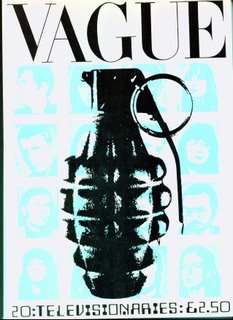

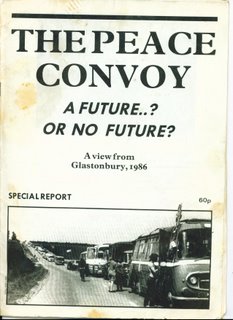

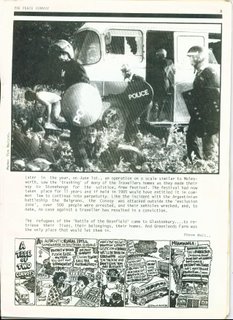
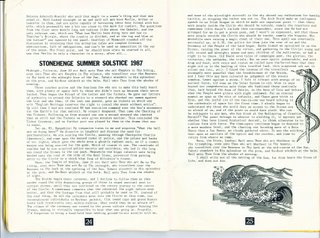
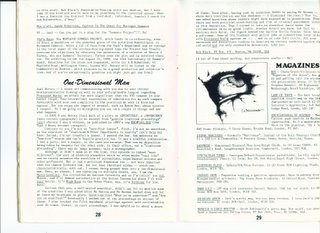
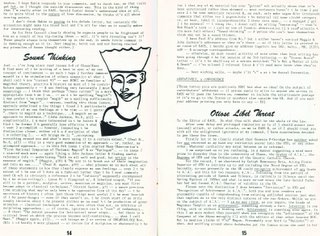
Bit of a random selection here: pages from Chaos International, Vague, Chaos, and Peace Convoy booklet which cross reference each other.
And our All the Madmen Zos Kia single.
This was sung by Min who was later in the Battle of the Beanfield- see peace Convoy scans.
The record was produced by Alex Fergusson see his website
http://www.alexfergusson.com/14206.html
and Alex was a mate of both Sandy Robertson ( see his letter to Joeal/ Chaos here) and Tony D.'s
Altogether a fascinating web of mid/ late eighties signification. If you can decode it.
Chaos magick / punk crossover



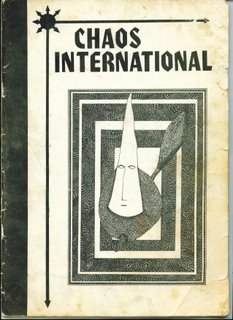

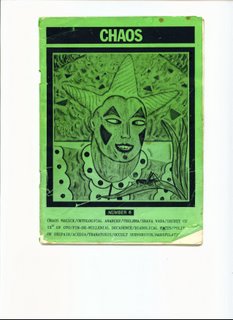
Nick Blinko of Rudimentary Peni contributor to Chaos International!
A few months ago, Tinsel sent me a copy of Nick Blinko's book The Primal Screamer first published in 1995, now on its third edition. It has a short section on the Wapping Autonomy Anarchy Centre which have scanned in. Nick's group Rudimentari Peni played there several times - pushing the boundaries of 'punk' to the edge and beyond.
This morning I went to scan in the cover Chaos International 3 (1987) and thought it looked familiar. It was drawn by 'Nicholas Blinko', who also contributed art work to CI 4 and maybe more- haven't
checked yet.
So there in black n white is an independent ( i.e. nothing to do with me) link from the anarcho-goth-punk scene of 80/84 with chaos magick.
Chaos magick, or results magic as it was first called, is strongly linked wth Leeds where it emerged in 1978/9 - contemporary with the Gang of Four. However I doubt if there was any actual connection at that time.
Here are some scans to illustrate the overlap.
Friday, November 18, 2005
Cabaret Voltaire: kultur vs zivilisation/ Fireworks


Rip up the rites of spring and start again.
0. Dark space behind the eyes, beyond physical sight. A Chaosmagick cyberspace, psychedelic slow motion maelstrom where ideas and energies, drift and shift and flow - then suddenly coalesce along some hidden fault line, the phases space reconfigures and a pulse of intensity ripples out, flashing over, arcing into the sphere of the physical, leaving tracks of its passage, like a particle of cosmic energy in / through a cloud chamber. We are Fireworks , irridescent globules strung out like dayglo beads in the darkness.
0.1A description of the neural pathways of the brain? The flux and flow of sub-atomic particles? The birth and evolution of stars and galaxies? The synasthaesic description of a piece of music? The transmission of ideas across and through culture?
0.2 From context, probably the last. A fractal like branching - so difficult to map with any precision onto any particular segment of spacetime. The crucial 'statement of belief' is that ideas have an energy. In some situations, the energy is intensified; in others it is dissipated.
0.3 To give an example : that punk was an 'energy' which reproduced itself many times in many situations (places/ people). The difficulty is that this way of experiencing a historical process is derived from an occult or magickal world view and thus conflicts with more rational world views.
0.4 Then why use it? Well, on the grounds that it offers me a wau to get my head round what would otherwise be a confusing and chaotic barrage of information. It is like Levi-Strauss' description of the shaman offering a 'myth of meaning' which makes sense of anotherwise chaotic reality. [ See my 'Culture as Heat' http://greengalloway.blogspot.com/2005/05/culture-as-heat.html for more on this theme]
0.5 So that the energies and influnces which fed into punk (inputs) and the energies and influences which came out of punk (outputs) are understood as reflicting the energies of a mythic struggle - kultur vs zivilisation.
1.kultur vs zivilisation
1.1 Since I have only just read Eksteins' book and maybe haven't quite digested his arguement, I'll try and spell out what I think he is on about. Germany as a unified nation-state only began in 1871, after the Franco-Prussia war. This new state also went througha rapid process of industrialisation, jumping ahead of Britain, where the process had built up slowly over 100 years or so. The newly unified Germany had no 'national' history, (although looked back to the era of the Holy Roman Empire ) but in its disunited form had been home to dozens of top-class poets, musicians and philosophers (Goethe, Beethoven, Hegel etc). The new Germany was also now home to cutting edge industry, technology and science.
1.2 The end result was that the new Germany saw itself as a dynamic entity having a historic 'destiny' [duty even] to create a new world order. Aspects of this harked back to the mythologised struggle between the Roman empire and the Germanic tribes (including of course the Goths) - in which decadent Roman 'civilisation' was reinvogorated and transformed by the natural energy of the Germanic tribes this creating Charlemange's Holy Roman Empire. Rather than the alternative point of view in which Roman civilisation was destroyed by the Goths, Vandals and Huns.
1.3 In this mythic re-construction of history, German ' kultur' represented and mannifested all that was new and progressive, whereas France and, especially, Britain represented a 'zivilisation' which was old, worn out and stultifying. Of particular annoyance was the fact that the French and British Empires has already laid claim to large chunks of the world, thus denying the German's their 'place in the sun'.
1.4 By 1914, the dangerously deluded but deeply held/ shared belief that a war between the forces of kultur and zivilisation was inevitable had taken hold in Germany. The theory was that this would, like the Franco-Prussian war of 1870 would be short and sharp. Kultur would inevitably (since it had the weight of 'true' history behind it) truimph over the decandent forces of Franco-British (and now Russian, thanks to entanglement with Austro Hungarian empire) ) zivilisation. The twentieth century would dawn as the beginning of a new age...
2. The Age of Force and Fire
2.1 Although what is now Iraq can claim to be the 'cradle of civilisation' - home to Uruk and the first city states of Sumeria- the physical remains of ancient Egypt have survived in more impressive form. Thanks to the invasion of Egypt by Napoleon 200 years ago, the historical significance of Egpyt as an ancient civilsation was absorbed by European culture- helped by the eventual translation of the Rosetta Stone.
2.2 The ability to translate Egyptian texts opened up the richness of ancient Egyptian religious beliefs. These in turn informed and deeply inlunced the structure of a Victorian magical society/ order called the Golden Dawn. Edward Alexander (Aleister) Crowley joined this order and when he set about creating his own magical system, he recycled Golden Dawn themes, including their ancient Egyptian cosmology.
2.3 During a stay in Cairo in 1904, Crowley had a visonary experience/ revelation. From this vision he realised that the old worldorder was dying and and a new world order was struggling to be born. Thanks to his Golden Dawn initiations, Crowley was able to structure this massive eruption of 'unconsious' energy. The old world order was that of the Egyptian godform or 'neter' Osiris. The new, that of Osiris' son, Horus.
2.4 Crowley's vision was set out in an inspired text called The Book of the Law. This text Crowley claimed was dictated to him by a 'praeterhuman' entity/ intelligence called Aiwass. Praeter is Latin for 'leading' or ' in advance' as in the Roman 'Praetorian Guard' - the shock troops who were first in battle, but who later became the Emperor's personal body guard. Praeterhuman would thus mean 'in advance of humanity' or 'future human' - Neitzche's 'superman'.
2.5 Crowley went on to claim that the mere publication of this revolutionary text in 1913 and then again in 1938 (with much benefit of hindsight) triggered the two world wars... Which is bullshit to the nth degree, but no doubt why AC still figures in popular culture whilst other magicians do not.
2.6 On the other hand... if the new aeon of Horus can be equated with German 'kultur' and aeon of Osiris with 'zivilisation', maybe he was on to something. Maybe he had tapped into something which was in the air. As with the Rites of Spring in avant garde culture.
2.7 A 'something' which as the Great War turned into the deliberate ( becuase no other way of fighting modern war emerged) destruction of millions of young men 's lives gave birth through death to Dada and the Cabaret Voltaire. To surrealism and the situationists. To our 'counterculture', which is BOLD STATEMENT the Hegelian synthesis which has emerged/ evolved out of the conflict between zivilisation as thesesis and kultur as antithesis.
3. So what?
3.1 To ask ' So what?' is the correct punk/ countercultural response to such imaginative speculations.
3.2 What difference does it make if I am right? I don't know. It kinda makes sense to me, but then I have spent thirty years or so wrestling with such possible ideas. So I can jump from vague notion to vague notion on the back of hours/ days/ years of taking vague notions (desires) for reality. It could take another 30 years (if I get to live that long) to be able to present some coherent version.
3.3 But so what. Today the sun is shining, but not quite melting the frost. My 19 year old daughter has gone to London on her own after four years struggling with clinical depression. She should be around Watford by now....
3.4 Zounds: Subvert.
Subvert, subvert, subvert
If you gotta job, you can be an agent
You can work for revolution in your place of employment
Subvert
Thursday, November 17, 2005
Industrial landscape
 Up early this morning to try and take some photos on a frosty morning. Walked round Carlingwark Loch to phot the crannog site and also these flares of light - reflections of reflections, sunlight hitting windows of old folks home and then bouncing off the surface of the loch.
Up early this morning to try and take some photos on a frosty morning. Walked round Carlingwark Loch to phot the crannog site and also these flares of light - reflections of reflections, sunlight hitting windows of old folks home and then bouncing off the surface of the loch.240 years ago this was an industrial landscape, the loch partially drained so that marl (lime rich clay ) could be extracted. A short canal was built in 1765 to carry barges fileld with marl upstream.
As I was waiting for the sun, I was thinking about Simon's book and the way he related different groups to their places of origin- industrial decay in seventies Sheffield, Leeds, Manchester and the musics which came out of those cities. I think he also mentions Throbbing Gristle and Hackney in a similar context.
Hackney was then and still is a London version of
decaying Victorian industrial environment. But when
I asked Gen (1984ish) if he had been 'inspired' by Hackney
he said NO. He hated the place and was only too happy
when PTV relocated to Brighton. Not sure when they did
but they were there by 1990 - Maggie and Mike
(Soror Nema and Frater Lyrus/ Maat magick) visited
them there. I could be suffering false recovered
memory syndrome, but have vague notion
that Gen popped into our flat in Hackney to visit M and M
when they first arrived.
Maggie also visited with K. Grant on that trip.
Typical, I came up with a whole narrative this
morning about Cabaret Voltaire, the Fall . TG etc and
now it has gone.


Wednesday, November 16, 2005
The Associates: KYPP 4: 1981

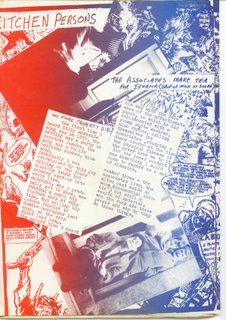
Serious readers please ignore first image - Throbbing Gristle and Tesco...
The other images are for Simon. In Rip it Up and Start Again, he rates The Associates very highly. Not quite finished reading the book, just up to the Goth pages. Which are/is confusing. I tend to see Kill Your Pet Puppy as being in the 'anarcho-punk' camp, yet we featured far more proto- goth groups than anarcho ones - Bauhaus, Sex Gang Children,
 Southern Death Cult, Alien Sex Fiend... and were Rubella Ballet AP or goth? Hmmm. And both Brigandage and Blood and Roses played Centro Iberico. Blood and Roses played one of their first gigs at the Wapping Autonomy Centre.
Southern Death Cult, Alien Sex Fiend... and were Rubella Ballet AP or goth? Hmmm. And both Brigandage and Blood and Roses played Centro Iberico. Blood and Roses played one of their first gigs at the Wapping Autonomy Centre.How about ABC/ Lexicon of Love- must have been one of Pinki's absolute fave records- played it to death/ scratched to hell. A Greenham sound track album? But then she did say that one time she and the other women were given a van load of cocktail dresses and danced around in the mud singing 'The Look of Love"... allegedly.
Anyway, anyhow, anywhere... Billy Mackenzie did once stay over night at Puppy Mansions and so the wildest shores of our version punk as a situationist/ surrealist continuation/ evocation of an eternal revolution and Simon's inspirational advocacy of The Associates as post-punk musical revolutionaries cross over an overlap with this article by our Iggy.
Kill Your Pet Puppy 5 June 1982
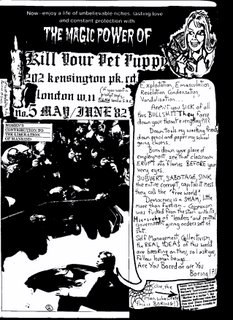
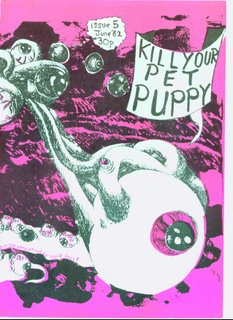 OK here we go now, another sociology lecture, a bit of psychology, a bit of neurology, a bit of fuckology, no fun... But it was fun, it still is lots of fun. Or was it? Is it? Min and Bob have both questioned that. The actuality of survival living in squats was not fun. What may seem in hindsight as a creative and exciting time was not at the time. The feeling of 'Isolation' (Joy Division song) of being alone amidst all the anarchic chaos and confusion has to be set against attempts to historicise and recuperate the reality.
OK here we go now, another sociology lecture, a bit of psychology, a bit of neurology, a bit of fuckology, no fun... But it was fun, it still is lots of fun. Or was it? Is it? Min and Bob have both questioned that. The actuality of survival living in squats was not fun. What may seem in hindsight as a creative and exciting time was not at the time. The feeling of 'Isolation' (Joy Division song) of being alone amidst all the anarchic chaos and confusion has to be set against attempts to historicise and recuperate the reality.Here are some pages from KYPP 4, created in the midst of it all. The same issue had a piece
by me on The Wise Wound
(about menstruation), by Cory on 'Make up
for Urban Guerillas'
Iggy on the Sex Gang Children
Tony on The Turdburglars and
lots more.
My bit on the Centro Iberico /Wapping is pasted back to front.
Sorry. Also note Ecology Party flyer -this became the Green Party...
and so gives a link from KYPP/ Punk to Undercurrents and pre-punk
radical alternative counterculture.
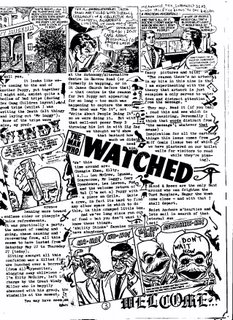
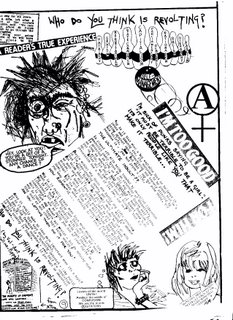

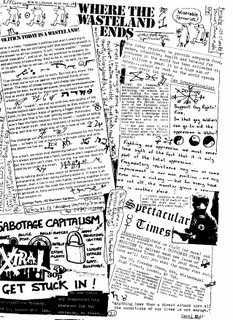

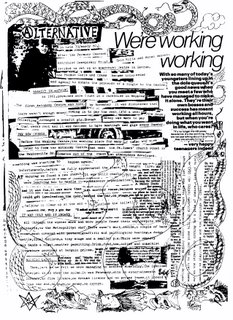
gay punx rip it up and start again
 Had gmail fromIan about 51 Huntingdon Street and an article Pip wrote about Gay Punx. We used this in Kill Your Pet Puppy 4 , although in cut up form - here it is. It should enlarge when clicked on, but not sure how readable it will be.
Had gmail fromIan about 51 Huntingdon Street and an article Pip wrote about Gay Punx. We used this in Kill Your Pet Puppy 4 , although in cut up form - here it is. It should enlarge when clicked on, but not sure how readable it will be.51 Huntingdon Street features in on old blog 'Subway surfing anarcho-goth-punks' - about going to a Barracudas gig at the Hope and Anchor and the discovery of a 'Parallel Universe' in a squatted church on Pentonville Road. I think also mentioned in very first( March) blog 'In the beginnnig there was punk'.
Just got (this morning) Simon's book on post-punk. Bit embarassing, should have had it months ago but had some problems with Amazon refusing to accept my money... and not on sale locally. But then my fault for living in a cultural wasteland. Lovely scenery though.
Already spotted that Simon mentions theLeeds Futuramas as beginnings of Goth. And Richard's NME Positive Punk
piece. KYPP seemed to straddle ths future divide, between
'anarcho-punk' and 'goth'. More on this theme to follow.
Plus have now finished the Rites of Spring book. Wrote a
whole chunk on it and implications- kultur vs zivilisation
but it vanished into cyberspace never to return. Curses.
So will have rip it up and start again. But see Simon has
several mentions of Dada in his book, so maybe a chance to
cross-reference.
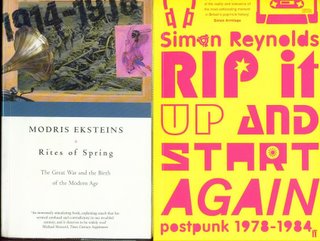

Monday, November 14, 2005
Brigandage have a website!
Here it is http://www.brigandage.com/pages/1/index.htm
Only just found it a few minutes ago, but already spotted a letter from Michael Moorcock re the notorious 'positive punk' tv (as in television) documentary.
This is fun.
What next? A Hagar the Womb website? Rubella Ballet? The Mob? Blood n Roses?
Come on kids, lets go for it! Dodgy Anarcho-Gothic Punk in Cyberspace!
Oh Bondage, Up Yours Crass - dayglocrazycolourherstory- its the only way to be...
Get in touch directly / brand new member of Puppy Collective

I find the 'comments' process a bit clunky. I did post a direct e-mail link ages ago, which Daragh found. I was worried about getting lots of spam, but filters seem to work.
I have a gmail address which isn't used much/ at all : alistair.hml@gmail.com so if you want to complain about how I have got it all wrong - or not, have a go. So long asI remember to check for messages!
Also - Just had message from Tony ( D) and Michelle
Born this morning [ 14 November 2005] at 8.17am.
8lbs 7ozs
Baby girl.
Ain't she cute? Looks like she may be a future Druid....
Crass Not Punks: Demystification or Recuperation?
Crass barely made a dent in the USA, so we're way behind in comprehending their significance. My sense from reading Brit scholars is that Crass and other bands (led by the Clash and others) became more political in the late 1970s, when the National Front began to appeal to some punks...
Crassand co. amplified the politics of punk. There was an urgency on the part of the Clash and Crass, to make their anti-Nazism loud and clear, and--for some--to develop not just a politics of negation ("we're not racist"), but a politics of creation, vision, struggle.I would guess that they had a rather unique anarchist bent on politics inthe UK , rather than the more ordinary ("liberal" in the States) left-wingpolitics. DIY, full refusal of power, etc.
The left in the UK, including even the socialists + commies basically had real access to power. It's so
unlike the US!
Anyhoo, I,m really not qualified to speak to the politics of Crass and theUK, at least not to a British audience!
I will say this (authoritatively, harumph, harumph): scholars and historians nearly ALWAYS focus on the bands and celebrities of punk! Such a bias produces very slanted narratives, and largely dismiss the punk on the street. (It's the same phenomenon as historians who tell the history of the US according to its lineage of presidents and generals, without reference to workers, women, slaves, soldiers, etc.)
So the disappearance of Crass results from the same problem.
To see "punk" as Savage and others see it is to miss the whole and misunderstand it altogether.
Hooray for McKay--he shows the depth of DIY. [Quote ends]
I got in touch with Dylan ( ages ago) after discovering this article by him:
http://spot.colorado.edu/~dylan/PunkLastSubculture.pdf
Ever since I wrote a review of Dick Hebdige's 'Subculture: theMeaning of Style' for Kill Your Pet Puppy 4 in 81, been fascinated by 'academic' representations of punk - following from these lines by Robert Burn's
Oh wad some power the giftie gie' us
To see oorselves as ithers see us
-especially after discovering Hebdige's book in the locked cabinet part of the social anthropology department
library at SOAS.
With punk, the image that always comes to mind is of the event horizon surrounding a black hole. There was punk as I experienced it viewed from the outside, from a rural teenagers perspective, where the closest to the actuality was when the Rezillos played CD town hall in summer 1977 and only one person had managed toget hold of a copy of God save the Queen under mysterious circumstances (posted through his door in the middle of the night!)
and then there was punk as experienced viewed from the inside by myself in London as a member of the (Kill Your Pet) Puppy Collective. Beyond the event horizon of punk, the reality was far more confusing. The word itself vanished. Instead there were hundreds of distinct individuals, each with their own trajectory across the event horizon, drawn from all over the UK, Europe, Australia, USA, even South Africa. It was never monolithic, never solid or fixed, but in a state of constant flux and change. There were a variety of 'strange attractors' (to use chaos theory) - certain squats or geographical locations, groups, fanzines, ideologies around which clusters would develop- but then they would break up and reform arond another strange attractor.
In retrospect, a degree of self-organisation took place- so that out of the hundreds, thousands even; of potential links/ bonds/ relationships a handful have survived for what is now 25 years. The most intense obviously being that between me and Pinki since it resulted in reproductive sexual union (= we had lots of kids and lived together for 12 years until she died). But there are a whole set of less intense links which have also endured and which have over time generated a fair bit of 'cultural reproduction' - fanzines, records, inspirations, arguements, conversations, letters, e-mails = 'magickal children'.
In comparison, despite spending five days a week for seven years in a work place community, no similar set of long term relationships emerged. I walked out of the factory gates of London Rubber in December 1983 and it and everone who worked there vanished from my life. Not just gone, but gone completely.
Why should one form of intensive subculture; that of the work place, leave no trace: whilst that of another, punk, has left its 'lipstick traces' all over me? To which one should add various other subcultural entanglements, which (e.g. chaos stuff, green/ham stuff, pagan stuff, traveller stuff, etc) although not as strong, are still here in the background/ ambient mix.
But back to Dylan's comment. Whilst Crass may seem to be, from an outside/ cultural studies academic perspective to be at once significant and ignored - only the Pistols and Clash figure in such narratives of punk-
from inside the belly of the whale, Crass seem to be given undue and over significance in those (more perceptive) academic narratives which try to get beyond the recuperation of punk
as a spectactular ' (sub) culture of resistence'.
Focus on Crass and you blot out and obscure/ elide the actuality of punk's diversity and creative chaos. Indeed, there is an argument that Crass were not 'punk' at all. That Crass may have taken and used elements of punk as a subcultural style, but that does not make Crass punk. As members of a post-sixties intellectual avant garde privileged elite, living in their Safe Epping Forest Home [Dial House] Crass aopted the style but not the substance of punk. Dial House was never a squat and its inhabitants never had to confront the 'in yer face' reality which the survivors of the punk squatting scene had to as part of their daily life.
Neither did I. I lived for the duration in a bedsit in Ilford, whilst working for London Rubber . But I did 'marry into' and was intimately engaged with those who were .
To conclude: the choice is between recuperation and demystification.
To promote, to advocate, to fetishise Crass as in any way representing an 'authentic' strand of punk is the way of recuperation. What is needed is to demystify and contextualise Crass and thus reclaim the actulaity of punk from its spectacular recuperation.
I look out the window and I wonder at it all
Staring at the circles that decorate the wall
Everybody's going to come and join them all
But I can't go with no one till I understand the call
Don't come round for me unless you got what I
Don't come round for me unless you got what I
Don't come round for me unless you got what I want
I want some Demystification
I want some Demystification
I want some Demystification about what's going on
From Demystification by Zounds
Sunday, November 13, 2005
Origins of Goth? Positive Punk -NME February 1983
 Oops, I've done it again!
Oops, I've done it again! The following is based on Richard's 1983 NME piece on 'Positive Punk' and there are several mentins of Michelle of Brigandage in it. In Jon Savage's England's Dreaming page 213 there is a photo of Michelle between Siouxsie and Severin of the Banshees waiting to get into the 100 Club on 20 September 1976.
The following is based on Richard's 1983 NME piece on 'Positive Punk' and there are several mentins of Michelle of Brigandage in it. In Jon Savage's England's Dreaming page 213 there is a photo of Michelle between Siouxsie and Severin of the Banshees waiting to get into the 100 Club on 20 September 1976.So I have scanned it in just to make the point of continuity between 76 and 83. Twice.Just had phone message from Min so will post this blog now.
Alistair
Amongst the yellowing press clippings, faded flyers, out of focus photos, falling apart fanzines, scratched and scored vinyl and unreliable memories gathering dust in boxes underneath my bed and which have survived numerous attempts to ' rationalise the archives' are some pages from a nearly 23 year old issue of the NME which are slowly deconstructing themselves back to wood pulp.
[See http://greengalloway.blogspot.com/2005/05/culture-as-heat.html which has also been sampled as 'Cultural thermodynamics' at http://www.cowlix.com/site/node/265 for 'entropy' as factor in historical discourse]
Fortunately the process of entropy (the heat death of the universe which so worried late Victorians) has been briefly held in check by websites dedicated to the history of Goth and Punk respectively. So, if you choose to accept the challenge, you can still read Richard Cabut / North's / Richard Kick's front page 1983 NME article.
http://www.geocities.com/punkscenes/nme.html which includes the photos
This text only version from http://www.scathe.demon.co.uk/posipunk.htm
Richard North's article on "Positive Punk" from the NME, February 1983, provides a colourful overview of the fledgling scene (many thanks to Greylock for locating and transcribing it for me). It's worth noting, however, that Brigandage and Blood and Roses were nowhere near as important as they were made out here - the two new bands who were really important were Southern Death Cult and Sex Gang Children. Richard North, however, may have been a little biased, as he later went on to join Brigandage.
Mick Mercer added the following cautionary comment in a recent email:
"People need to remember Richard wasn't talking about anything other than a certain attitude of a very few bands in his Positive Punk article and he had no intentions whatsoever of proclaiming a movement. He was as mystified as anyone when the article made the front cover and was talking about thing in the way people now imagine. It was the sub-editors, on a presumably quiet week, who made this all up. He was just on about looking at a more imaginative Punk strain of thought, not a movement."
From NME, February 1983:
Is it too early for a '76 punk revival, or are these new warriors part of a brand new positivism in '83? RICHARD NORTH treads through the Blood And Roses of a new movement to uncover the answers. Photos: ANTON CORBIN
"Don't dream it, be it" - Rocky Horror Show
{PIC: Left to Right: Scott and Gez (bassist of Brigandage and Blood & Roses respectively); Bob (guitar with Blood and Roses); and a fan called Sean.}
PART ONE
THE BOY sits before the staring mirror and ponders his clean-shaven reflection. Smiling, he selects a carefully complied tape and slots it into his machine. 'Fatman' is the first track: Southern Death Cult excite him and he dances in his seat while unscrewing a tube of foundation cream
He's got to look good tonight - and it's becoming every night - because he's off out to a gig. He's going to see one of his bands, one of the groups he regularly sees. Brigandage, Southern Death Cult, Danse Society, Ritual, Rubella Ballet, Virgin Prunes, Specimen, The Mob... they're the only ones who mean anything to him anymore.
Tonight it's Blood And Roses at London's Moonlight Club and all his friends will be there. One of their tracks, 'Your Sin Is Your Salvation', comes up on the tape and the boy remembers the last time he saw them.
The blur of colour, the heady atmosphere, the fun, the collective feeling of motion - forward! - it made him feel alive, positive, and then he formed a group the next week.
Finishing his make-up the boy turns his attention to his dyed blue hair, carefully back-combing it into disarray. Last week he'd been beaten up by some skinheads because they didn't like the look of him. He remembers their fury but shrugs: he enjoys his appearance and is proud to look different. In a way he's almost glad that his clothes and attitude had provoked the attack - their mindlessness wrapped in a dull, grey, lazy uniform of bitterness gives him a reason to be their opposite.
{PIC: Scott - bass player with Brigandage}
He feels bright and optimistic about the future, slipping into a pair of leather trousers, noticing he's only got few quid left in his pocket. It doesn't matter though, the dole gives him time to do things, like his group.
A Brigandage number blares out: 'Hope', it seems to sum things up for him. With its message on his lips the boy half-dances across the room, through the door and out.
PART TWO
"I don't like the word movement, but there's now a large collection of bands and people with the same positive feeling."- Andi, singer with Sex Gang Children, speaking on the opening night of Son of Batcave.
HAIL ERIS, Goddess of Discord, and pass the ammunition: as the heavy drumbeat rolls and the harsh chords crash and sometimes even tingle, it's then that the boys and girls come out to play. Play power!
With wild-coloured spiked hair freezing the eye, and even more vivid clothes to spice the imagination -faces, thoughts and actions - the atmosphere's infused with a charge of excitement, an air of abandon underlined with a sense of purpose.
Something stirs again in this land of fetid, directionless sludgery, this land of pretend optimism and grim reality. Theory and practice are being synthesised under the golden umbrella of a two-hour long ideal.
Welcome to the new positive punk.
Although it's not the purpose of this article to create any kind of movement or cult, any easy or accessible bandwagon to be tumbled onto, it is indisputable that a large number of bands and people involved in the culture called rock, have sprung up at approximately the same time, facing their lifestyles in the same direction. Maybe unconsciously so, It's a huge collective force that we can call the new positive punk- a re-evaluation and rejuvenation of the ideals that made the original outburst so great, an intensification of and expansion of that ethos of individuality, creativity and rebellion. The same buzz that burned our streets in '76/'77 is happening again.
The Industrial Revolution is over, a new movement has begun, and the current mood is an affirmation of that point. The natural energy that for over 200 years has been poured into the physical, the rational and the materialistic, has now all grown crooked.
{PIC: Lisa and Sean}
The mental/magical power has been lost: It was simply not needed - steam engines, radios, electricity were so much easier and they worked. But now the glamour is wearing off. We can see the string and wires, the clockwork squeaks ... the radiation is beginning to corrode the pretty box. [ Fess up time- Rich knicked these bits in italics off me]
All the darkness and light, all the forces are still there deep underneath, bubbling, steaming, fermenting. The instinct, ritual and ceremony are rising again in everyday life; many people are starting to use the tarot and I-ching. And the new punk groups are a reflection of this feeling; their use of mystical /metaphysical imagery and symbolism is a striking common denominator. Not in the way of dumb-dabbling and superficial posturing of, say, a Black Sabbath with their (gasp) black magic kick.
Nor is it a silly hippy Tolkien fantasy joyride, or even a Killing Joke stench-of-death gloomier-than-thou slice of fanaticism. It is, instead, an intelligent and natural interest in mystery, rather than history, that is a sign of an open mind.
These groups are aware: UK Decay (positive punk forefathers), using the dark to contrast and finally emphasise the light; Sex Gang Children taking us into the sub-world of the Crowleyan abyss; while Blood And Roses are pushing the symbols a whole lot further, their guitarist Bob being a serious student of the Art. The mystical tide we are talking about here refers, if nothing else, to the inner warmth and vital energy that human beings regard as the most favourable state to live in. The new positive punk has tapped into this current.
And if all this sounds a touch heavy, let's consider the humour, style and inherent fun that are essential parts of the movement. Let's look at groups like Specimen, who are more Rocky Horror than Aleister Crowley, preening themselves in glam-soaked traipse among the ruins. Or The Virgin Prunes' cheeky on-stage oral sex send-up. The real humour is intermixed with the sheer sense of joy de vivre present at such gatherings.
Here is a glow of energy and life that overcomes the need for artificial stimulation. Unlike the heroin or barbituate sodden club scene or the glue swamped Oi/punk arena, the emphasis here is not on drugs. Although illicit substances are not unknown, the desperate desire to nullify boredom is not present, and therefore there is no narcotic edge to the scene. Members of several groups (such as Southern Death Cult, Sex Gang Children and UK Decay) do not even drink.
For perhaps the first time, an active and flourishing disenting body will not go down with its hind legs kicking as the drug takes over.
Money and time are tight: so both of them are being spent on something far from enjoyable and important: style. There's a veritable explosion of multi-coloured aestheticism. So different from the blend, stereotyped Oi/boothby/punk fare of jeans, leather jacket and studs, this is an individualist stance even if it tends towards a common identity. A green-haired spike-topped girl wearing a long black pleated skirt, white parachute top and bootlace tie passes a tasselled, black-haired mohawk in creepers, white socks, red pegs and self-made, neatly printed T-shirt. Something clicks. They smile in acknowledgement.
We are fireworks.
PIC: Richard drummer with Blood And Roses, and Steve, a fan.
PART THREE
"I think that our influence comes from the fact that there are so many negative bands around. We're not - so away we go!"- Bob, guitarist with Blood And Roses, Stoke Newlington
If the bands absorb, reflect and present (not necessarily in that order, It's a gave and take thing) the attitude of their fans and the tone of their surroundings-and I think that the important ones do - then we can trace the whole thing back to its roots, travelling through the erotic politics of the influential Doors and the tense dusky danger of The Velvet Underground, then we come to The Sex Pistols, who operated under a vicious amalgam of style and direction.
Projecting a perfect combination of distorted but relevant aesthetics, music and suss, their all-important important effect was the provocation of thought.
Then, veering away from 1002 misdirected cardboard copies, we come to the Banshees and the Ants. These two are important to the new positive punk: the Banshees because of their sheer power of imagination, and the Ants because of their promotion of the sensuous 'black' style.
Both had an adventurous and rebellious air about them that cut through the regressive dross. Their outlook, musically, and in angle of thought, went beyond the proscribed boundaries of behaviour at the time. They explored the edges of light and dark and some of the areas in between. They were a progression and they are the two clearest reference points to this recent outbreak of energy.
PIC: Mick - of Brigandage, and Michelle.
Back at the tail-end of '78 and beyond, punk spun into a tailspin of tuinol-dazed tiredness. A pause. Trends came and went: dead ends such as mod, new romanticism - up to and including funk craze - all took their toll on the vital energy. And those who stuck with the essence of their punk were faced with the development of Oi. Punk, under the guidance of certain lobots, gathered itself around a banner of no brains, no style, no heart and no hope, Heads buried in the glue-bag of dejection and floundering away under a barrage if three-chord rubbish - this is, and was, no way to lead a life.
Some drifted with the anarcho scene which at the time (1980/81) was the only worthwhile concern going. But by 1983, when everything is said and done, that angle seems too flat and puritan to be of much inspirational value. Crass, although anti-sexist, were and still are extremely sexless: a stark, bleak Oliver Cromwell new model army, who have sense but no sensuality. [ Key suggestion from within supposed era of Crass dominance of 'punk']
At the opposite end of the scale, inspired by the feeling of the Ants etc, come two groups who are the immediate forerunners to today's flood. They are Bauhaus and, later, Theatre of Hate - both of whom capitalised on the idea of style and, what is more, a 'dangerous' and sensuous style that attracted more and more fans who were sick of the bleak and macho Oi and the shallow cult with no name.
It's these fans, reacting against the devaluation of punk, and fired by the spirit of the above-mentioned mentors, who are acting now. They've created a colourful and thriving nation-wide scene - resplendent in their individuality but still linked by a progressive punk idiom, one that says go instead of stop, expand instead of contract, yes instead of no. A new, positive punk.
PART FOUR
"Stimulating thought, bringing people together, entertaining people, creating an atmosphere of sheer exhilaration and enjoyment. These are the main things." - Ian, singer with Southern Death Cult, NME 2/10/82.
Andi Sex-Gang twitches in the spotlight, the beam reflecting his harsh features and closely-cropped hair. He clenches his fists and spits out 'Into The Abyss'.
Ian Southern Death Cult flays his arms and chicken-wardances across the stage, a sharp youthful figure with black be-feathered mohawk. His song 'Moya', the words and power behind the words providing an insight into cultural stagnation. He howls in shrieks and defiance. Mark from The Mob, an anarcho-renegade, with his bleached dread hair stands up straight before the microphone, growling: "Still living in the English fear, waiting for the witch-hunt dear."
All this and more as Michelle Brigandage leaps onto the amp, top hat at a rackish angle "As we walk in the sunlight honesty protects our eyes," is her cry. And Bob Blood and Roses, he just grins, he knows … "Love is the Law" - their tale underlining the truly optimistic undercurrent to this mood.
And the fans. Bedecked in sparkling, inventive garb, they kick, they jump, they scream.
"A night for celebration, a night to unwind," repeats the diminishing echo from the ghost of UK Decay. "For celebration, celebration, celebration…"
PART FIVE
"There's nothing else. Everything else has been stripped from us, So now were' just gonna do it. There's no other choice," - Michelle, singer with Brigandage.
So here it is: the new positive punk, with no empty promises of revolution, either in rock 'n' roll sense or the wider political sphere. Here is only a chance of self awareness, of personal revolution, of colourful perception and galvanising of the imagination that startles the slumbering mind and body from their cloth.
Certainly this is revolution in the non-political sense, but at the same time its neither escapist nor defeatist. It is, in fact "political" in the genuine sense of the word.
Individuality? Creativity? Rebellion? The Synthesis comes at the moment when you do the one thing, the only thing when you know you're not just a trivial counter on the social checkerboard. Here are thousands doing that one thing: merging an explosive and cutting style with a sense of positive belief and achievement, and having fun while they're doing it.
The Oi-sters and their ilk have taken punk a few millimetres to the right or a centimetre to the left, but no one took a damn step forward.
This is punk - at last built on rock and not on sand.
Make Art not War - Crass' grand- dada?
Rites of Spring : The Great War and the Birth of the Modren Age by Modris Eksteins publiched by Papermac in 2000. I flicked through the pages and found this in the Preface
Our century [i.e. last century] is one in which life and art have blended, in which existence has become aestheticized. History, as one of theme of this book will try to show, has surrended much of its former authority to fiction...
For a mere £2.50 I had to ge the book. Only got to page 70 out of 370, but already found dozens of quotable quotes and unexpected revelations. It may take a wee while to digest, but as I do so will sample chunkcs and fold then int the mix. Existance has become aestheticized... sounds almost like a Situationist quote or Robert Anton Wilson and Shea's 'Immanatize the Eschaton' from their Illimantus trilogy.
Meanwhile, grok on this bit of dada...
Make art not war
Fot text plus images go to :
http://www.guardian.co.uk/arts/features/story/0,11710,1636718,00.html
Grotesque, absurd and angry, Dada exposed the violent truth of the 20th century. Yet it started so humbly, says Jonathan Jones Tuesday November 8, 2005 in the Guardian
The man in the photograph looks utterly serious in his tubular suit with the wizard's cape and the tall striped headgear. He called it his "cubist" costume and "witch doctor's hat". The cardboard get-up was so immobilising that he had to be carried on and off stage to recite his lautgedichte or "sound poetry":
anlogo bung
blago bung
blago bung
bosso fataka
ü üü ü
This was in 1916. What does this suggest? Mud, poppies, mustard gas. Rat-infested trenches. The youth of Europe dying.
tumba ba- umi
kusagauma
ba - umf
On July 1 1916, in just a few hours, more than 20,000 British soldiers were killed and about 40,000 wounded in the first day's fighting in the battle of the Somme. By the time it was over this one battle in the first world war would kill nearly half a million Britons and the same number of Germans. The photograph in the vitrine at the Pompidou centre was taken exactly a week earlier, on the evening of June 23 1916, in a nightclub in Zurich.
The man in the picture is Hugo Ball. Like young men all over the continent, this German philosophy graduate had volunteered for the war, but he was rejected as unfit. He visited the front line and came home a pacifist. With a young doctor called Richard Huelsenbeck, he organised anti-war protests in Berlin before emigrating to neutral Switzerland with his lover Emmy Hennings, a cabaret singer and prostitute.
The club they founded was called the Cabaret Voltaire, but it wasn't exactly redolent of the rationalism of the 18th-century Enlightenment its name suggests. Hennings sang and gave puppet shows; Ball, Huelsenbeck and the Romanian Tristan Tzara recited their pre-linguistic poetry, often at the same time; there were fake shootings and "negro chants", and Tzara's old school friend Marcel Janco made masks in which the performers became other, stranger people. The artists Sophie Taeuber and Jean Arp contributed coloured assemblages and wooden sculptures but it was Hugo Ball who gave the whole tangential enterprise a name. It is there, in the display case next to the battered old photograph, in the original typescript of Ball's first manifesto; the very first word - "Dada. . ."
All of this is textbook stuff. Dada is one of the central art movements of the 20th century and perhaps the one whose mystique survives most in our idea of what is subversive. Greil Marcus even argues in his great, mad book Lipstick Traces that its spirit returned in the Sex Pistols. You could also meet its ghost in post-Wende Berlin.
In Berlin in the early 1990s, the spirit of Dada seemed to infest every mouldering old cellar on Oranienburgerstrasse that had been converted into a crowded bar straight out of the city's pungent past. History had shattered, the frozen time of the Berlin Wall was over, and everything was up for grabs. British anarchists created a sculpture garden of missiles and weapons behind an old Communist factory. And in the museums, we saw such bizarre old stuff, resurrected with the city itself: Hannah Höch's photomontage Cut With the Kitchen Knife Dada Through the Last Weimar Beer-Belly Cultural Epoch in Germany (1919-20), George Grosz's painting Pillars of Society (1926) with its moustached capitalists whose heads are literally full of shit . . . art that is all but excluded from modern memory.
The art of Dada has been all but invisible, especially Berlin Dada, which has been eclipsed like the city that spewed it up. Now the vaults are open, and this epoch-making exhibition bears witness to the genius of Höch, Grosz, Raoul Haussmann and the rest.
Suddenly, nothing about Dada seems obvious when you see this show's abundance of works of art made in the name of anti-art. To begin in the Cabaret Voltaire: what exactly is the relationship between Dada and the great war? We know Dada was a "protest". But how, exactly? What this show reveals is that Dada had two quite different currents: the contemplative and the violent, or, to put it another way, Zurich and Berlin.
"In the liberal atmosphere of Zurich," remembered Huelsenbeck, ". . . we could scream out everything we were bursting with." And yet the surviving relics of the Cabaret Voltaire are quiet and pensive, a whisper not a scream. Even in that famous photograph of Hugo Ball, his face is so sombre. The artists most closely allied with the Cabaret, Arp and Taeuber, made almost mystical abstract works, wooden decorations for a sensitive child's bedroom. It also happened to be in Switzerland that Albert Einstein, while working in the patents office in Bern, had published in 1905 the special theory of relativity. He, too, was a pacifist. The philosophical games of chance that Dadaists enjoyed - Arp dropped pieces of paper at random to make collages - resemble Einstein's "thought experiments", and the resulting works might be pictures of the strange new worlds of 20th-century science. This is most obviously true of a painting that hangs in the first room of the exhibition. Marcel Duchamp painted Tu m' in 1918 for the artist and collector Katherine S Dreier. Duchamp didn't like her - the title is a polite shortening of "you bore me" - but he created a masterpiece whose shifting planes, perspectives and dimensions communicate fluidities of space and time.
In 1915 Duchamp, too unhealthy for the army, sailed from Europe for New York. He was in his late 20s and had already left aside his efforts at cubist/futurist painting to experiment with randomness and game-playing. Here you can see the Three Standard Stoppages he made by dropping three metre-long threads from a height of one metre on to a canvas and then sticking them where they fell. Here, too, you can see his bond for a company set up to beat the roulette tables at Monte Carlo.
Duchamp was a dandified metaphysician who preferred games to art. Yet he was a pure exponent of Dada. The movement's founders in Zurich were as enigmatic as he was, their sound poems just as bafflingly tangential: and he was just as much of an anti-warrior as they were. "We saw the stupidity of the war," he said in 1961. "Our movement was another form of pacifist demonstration."
The most straightforward Dada gesture in the entire exhibition is by Duchamp. In the almost obsessively archivist style of the show, there is a whole wall of defaced Mona Lisas - not just Duchamp's original "rectified ready-made" of 1919 but his notes, and later versions he made with his friend Picabia. Looking at them in series, you see how Duchamp's desecration is not an act of violence on the Mona Lisa. It rather draws attention to a dissolution that has already taken place. Duchamp has defaced a coloured reproduction, a "cheap chromo" in his words, of the painting. Dada is the first art movement fully to inhabit the age of photography in which every image can be easily and accurately reproduced.
Yet he is not the star of this show. The star is Berlin. In 1917, one of Dada's founders, Richard Huelsenbeck, came home from Zurich to Berlin. Early the next year he made a speech redefining Dada not any longer as contemplation but as apocalyptic reportage: "The highest art will be . . . the art which has been visibly shattered by the explosions of last week, which is forever trying to collect its limbs after yesterday's crash."
Everywhere you looked in 1918, people were torn up by yesterday's crash. A war veteran hobbled by on crutches or pulled his legless body along on a cart. Faces "visibly shattered by the explosions of last week" hid themselves in the back rooms of cafes, like the one in Dresden where Otto Dix saw mutilated soldiers playing cards and portrayed them in his phantasmagoric picture Die Skatspieler (Skat Players). Limbless, with glass eyes, patches over missing noses, tubes stuck into faces that are pummelled mincemeat, these men proudly wear their medals.
The grotesque has been a strength of German art going back to Dürer and Cranach. Think of the British war poets, then look at Dix's Skatspieler, and there's something quite different going on. Dix takes a monstrous glee in his very rage: he is not mourning these men but ranting at them, blaming them for their patriotism and passivity.
It's this unsentimental fury that makes Berlin Dada some of the greatest art of the 20th century. It is the highlight of this show, and doesn't conform to any cliche of what 20th-century art was like. Otto Dix exhibited his paintings at the first Dada show in Berlin, the International Dada Fair in 1920, which this exhibition partly reconstructs: he showed a very similar painting to the Skat Players, but with collage elements. It's lost, not by accident, but deliberately destroyed by the Nazis. Photographs show that over part of it hung George Grosz's smaller painting/collage A Victim of Society, which survives and is in this show.
A Victim of Society is instantly recognisable as one of those broken faces recorded in terrifying photographs of the first world war: this man has a hole where his mouth should be and a new mouth pasted in. He has a twisted and dislocated eye. The surgeon, in a cruel experiment, has given him an extra eye inside his ear. And then there's his head, mutilated by a giant question mark . . .
These are collaged disfigurements. Collage was first used by Picasso and Braque but in German Dada it is infinitely more brutal. It's easy to see how Grosz develops from painting to collage; the fragmentation and violence in his and Dix's paintings can be rendered all the more unpleasant by cut-up photos. Yet Grosz never made pure photomontage: in his images the stuck-on newspaper pictures and bits of photographed machinery always collaborate with Hogarthian satirical drawing.
His talent for graphics was vast: others were less reluctant to abandon drawing. Hannah Höch made pure photomontages: it's as if she has swallowed magazines full of fashion, sport, celebrity and art images - then regurgitated them in wondrous absurdities such as The Beautiful Girl, with its chaos of sex and cars and advertising. In Cologne, Max Ernst used photomontage, collage and drawing to create a phantom aircraft with a woman's arms menacing two orderlies carrying a wounded man across no man's land.
When we look at the remains of Dada, we see the 20th century with its skin peeled off. Surrealism was to reject Dada in favour of something supposedly less gestural. Yet Dada spoke the truth. It is revealed here as one of the richest of all art movements, and I have left out so much. But the great contrast in Dada is between the poetic mystics such as Ball and Duchamp, who were true pacifists, and the revolutionaries in Berlin - Grosz joined the Communist Party - whose art is a form of street-fighting. I can't help admiring their rage
· Dada is at the Centre Pompidou, Paris, until January 9. Details: 0033 1 44 78 12 33.
Friday, November 11, 2005
Crass, anarcho-goth-punk, neo-paganism and industrial music
Here are a couple of interesting comments on the story so far:
1.Chaos Magic is kind pushing it a bit. In Leeds maybe... but the links between neopaganism in general as a bridge between hippy, punk and later rave is a more viable conduit. Industrial culture generally is more specifically relevant than Chaos as a link (have you seen Phil Hine' s record collection??!). Esotericism always bridges generation gaps and hence mixes up musical genres. Also see: Robin's Greenwood Gang (ex-hippy anarcho pagan / traveller-related eco group that collapsed IIRC after getting beaten to a pulp by the brew crew for no good reason at all) and of course the Dragon Environmental Network, which is still going strong and scoring the odd victory. paul.meme
2. Dear Alistair,Very much enjoying your ruminations. Yes, Crass were aware of TG--they met at on at least occasion. Mutual respect as far as I know. The Crass-avant garde/electronic/industrial link went primarily through Annie Anxiety and led to such things as Whitehouse supporting Flux of Pink Indians at the Greyhound in November 1982, Steve Ignorant singing with Current 93 etc. etc.You're doing fantastic work in writing about this--keep it up!
Multi coloured spaghetti ; or there’s too much confusion, I can’t get no relief (line from a Hendrix song ? Quick google check- Dylan actually, but Hendrix’s version - All along the Watchtower)
"There must be some kinda way out of here," said the joker to the thief,
"There's too much confusion, I can't get no relief.
Businessmen, they drink my wine, plowmen dig my earth,
None of them along the line know what any of it is worth.
""No reason to get excited," the thief, he kindly spoke,"
There are many here among us who feel that life is but a joke.
But you and I, we've been through that, and this is not our fate,
So let us not talk falsely now, the hour is getting late."
All along the watchtower, princes kept the view
While all the women came and went, barefoot servants, too.
Outside in the distance a wildcat did growl,
Two riders were approaching, the wind began to howl.
Just from these two comments above, whole alternative/ divergent versions of mystory (myth + history) could be created. Never mind. Lets have a go anyway.
2. Comment 2 . Crass and Throbbing Gristle/ industrial music.
2.1 That is an interesting link. Have found from googling on Centro Iberico that Whitehouse played there in 1982. Throbbing Gristle played in 1979. Whitehouse playing with Flux? That is a wild one. Annie Anxiety did use ‘electronic’ backing tracks so an industrial music link isn’t so surprising. Steve Ignorant and Current 93 - but that was post Crass- or was it? Bit foggy on that. Although I do remember from a conversation with Gen P circa 1983/4 that Dave Tibet had joined the Typhonian OTO. Which is a bit cryptic- so I will adumbrate.
2.2 When Edward Alexander (Aleister) Crowley - whom I hope you have all heard off- died in 1947, he did not leave any clear successor to his role as Mr. Magick. This created a confusion which persists to this day, with several groups and individuals claiming to be the authentic inheritors of AC’s magical mantle. One of these groups is called the Caliphate OTO and were/ are USA based . A rival UK group, led by Kenneth Grant, is called the Typhonian OTO (OTO = Ordo Templi Orientalis , Order of the Eastern Temple).
2.3 During the 1970ies, starting with ‘The Magickal Revival’ in 1972 - which claimed horror fiction writer H. P. Lovecraft for magick- Grant wrote a series of weird and wonderful books which were a UK magickal countercultural alternative to Carlos Castenada’s more high profile shamanic ‘fictions‘. Or Robert Anton Wilson’s Illuminati trilogy. Grant also wrote a fairly straightforward book on Austin Osman Spare who had a huge influence on chaos magick. Grant is still live and well and still writing.
2.4 After Throbbing Gristle came Psychic TV, Coil and Current 93( plus Chris and Cosey’s projects ). PTV , Coil and Current 93 all moved from industrial music to magickal music. Some entanglements ensued. Joel Biroco of Chaos/ Kaos magazine discovered that circa 1986/7Genesis P of PTV/ TOPY had met with one David Rietti, then UK head of Caliphate OTO . This created a huge / tiny ‘stushie’ ( to use a good Scots word).
2.5 From the Kill Your Pet Puppy/ anarcho-goth-punk side there are lots of links. Mouse (whom I met at the Wapping Anarchy Centre in 81) briefly became a member of Psychic TV and was friendly with Coil and wrote for Joel‘s Chaos. Min recorded her song Rape with Zos Kia (PTV/ Coil offshoot) for All the Madmen before becoming a traveller - she was at the Beanfield in 85 . And - if you go back to blog archives for April 2005 more stuff.
2.6 Crass? Unless the works of Kenneth Grant were in the Dial House library, not much overlap/ connection.
1. ‘chaos magick- pushing it a bit’. Paul Meme
1.1 I know chaos magick was more of a late eighties/ nineties thing, bit it did have its origins in the late seventies and as a cultural phenomenon was part ( I reckon) of the seventies ‘underground’ expansion of late sixties counterculture. If you have noticed the Undercurrents magazines scans - in one from mid-seventies I found a review of Ramsay Dukes/ Lionel Snell’s SSOTBME (Sex secrets of the black magicians exposed). Unfortunately I sent Tom Vague that issue, but it was there, honest!
I am not sure how Lionel fits in with the development of chaos magick, but he was/ is an influence. Also Dave Lee - in an early Chaos International (3?) he reviewed a Vague and got nostalgic for the old situationist / OZ etc references. Will scan in. Not sure on Pete Carroll / Ray Sherwin’s roots, but they must have been of ‘that’ generation.
1.2 Phil Hine’s record collection? Intriguing. No idea on Phil’s musical interests / influences, no recollection of ever talking music with Phil. I do remember spotting that Dave Lee had Love’s Forever Changes in his collection which impressed me- one of my all time favourites. And that Nick Hall had 40 Hawkwind albums…
1.3 Robin’s Greenwood Gang. George Firsoff/ Greenleaf magazine . Knew George through Pinki/ Tanith‘s involvement in Stonehenge Campaign. But a problem came up when George had a go at Anne Barrowcliffe and Barry which got quite nasty.
1.4 Dragon Environmental Network. As you say, still going at
http://www.dragonnetwork.org/magic.htm
Is Adrian still living in New Cross I wonder? Tanith did some actions with them (and Shan/ House of the Goddess) in early nineties but - how can I put this politely? - Tanith was not very impressed. She felt they were fine at raising energy, but then lost the plot - energy raised has to be earthed in a very focused way. Which didn’t happen. She wrote an article on ‘Magick and Direct Action’ - must find and post here.
3. And Crass?
3.1 I guess that there are lots of strands all mixed up here, of which Crass and the politics of anarcho-goth-punk were just part of. Individuals moved between these strands,. creating their own diy mix of influences and actions- e.g. Steve Ignorant plus Current 93, or Annie Anxiety and (?) Whitehouse/ industrial music, Mouse and Coil. Min and Zos Kia. Dave Tibet and the Typhonian OTO. Etc, etc.
3.2 What may seem from a distance as distinct and even oppositional stances/ points of view/ ideologies blur and fuse when seen closer up.



